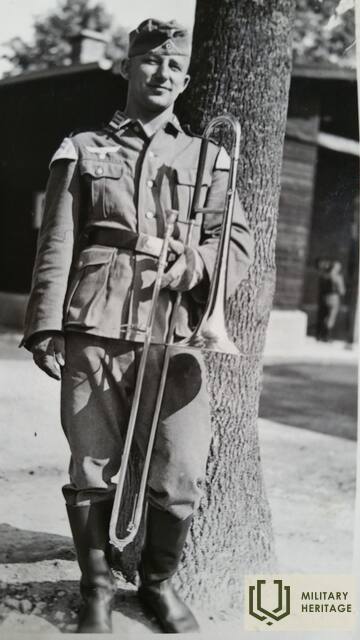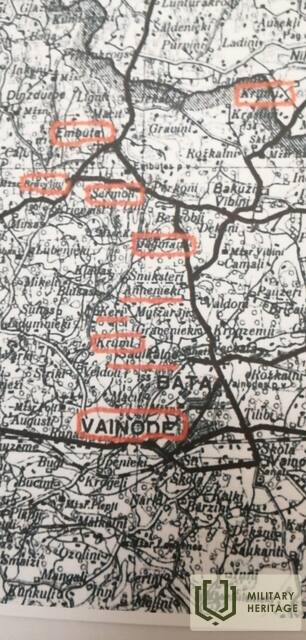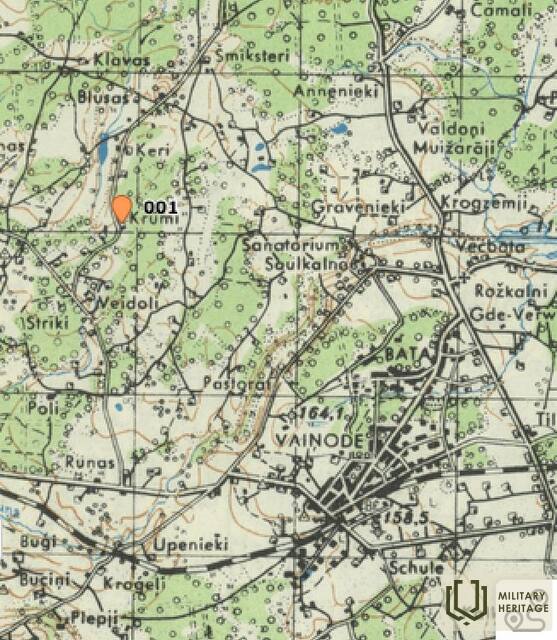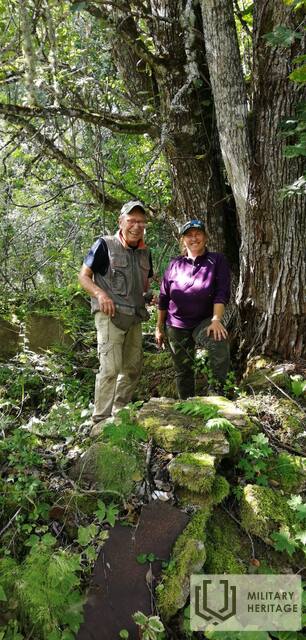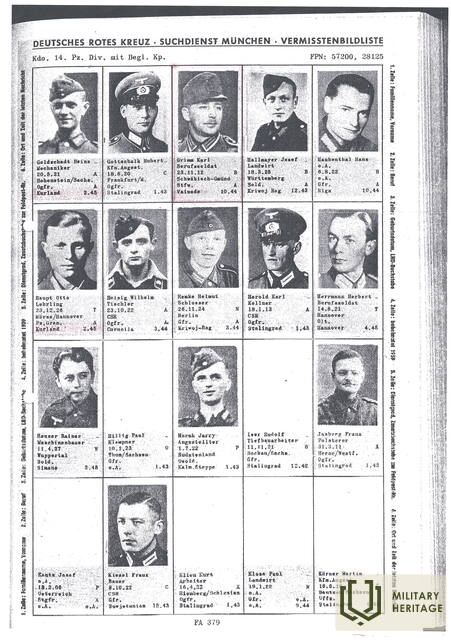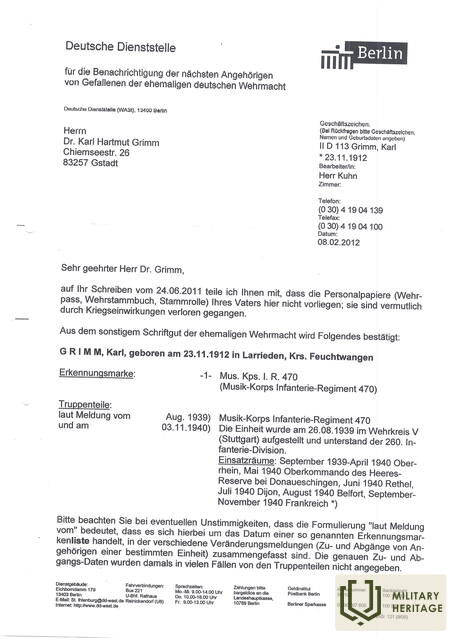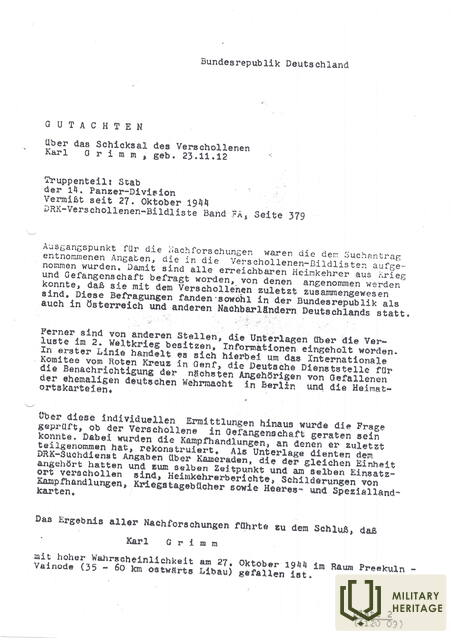Dingę vokiečių kareiviai Kuršo mūšyje - Karlas Grimmas
Vokiečių armijos grupės „Šiaurė“, vėliau pervadintos „Kurlandu“ per Kuršo apgultį, įrašuose vis dar nėra aiškios informacijos apie maždaug 50 000 vokiečių kareivių. Šie kareiviai yra įtraukti į dingusiųjų sąrašą. Net ir šiandien šių kareivių giminaičiai bando rasti savo giminaičių ir protėvių pėdsakų Kurše – tiek dokumentinių, tiek fizinių. Viena iš tokių istorijų – Karlo Grimmo, vokiečių kareivio iš Švabijos (istorinio regiono pietvakarių Vokietijoje, prie Reino ir Dunojaus upių ištakų), kurio karo karjera nutrūko 1944 m. spalio 27 d. Krūmų namuose netoli Vainodės (5 km į šiaurės vakarus nuo Vainodės, Latvijoje).
Karlas Grimmas gimė 1912 m. Larriedene, mažame Bavarijos kaimelyje, netoli garsaus viduramžių miesto Dinkelsbiūlio. Ten jis keletą metų grojo Dinkelsbiūlio jaunimo ansamblyje, o vėliau studijavo muzikos konservatorijoje Štutgarte, Badeno-Viurtembergo žemėje, kur mokėsi kapelmeisterio specialybės. Po 12 metų, grodamas trombonu Badeno-Viurtembergo žemės simfoniniame orkestre, 1931 m. jis savanoriškai įstojo į Badeno-Viurtembergo armiją. Nuo 1939 m. jis tarnavo Vokietijoje rezerviniame batalione, tačiau archyvuose yra 1944 m. spalio 27 d. įrašas, kad tą dieną jis dingo „Krum“ namuose netoli Vainodės, Kuržemėje. Karlas Grimmas turėjo žmoną ir 4 vaikus.
Paieškos Vokietijos Federacinės Respublikos archyvuose ir įstaigose buvo nesėkmingos, nes net apklausus išlikusius buvusius kareivius, niekas negalėjo aiškiai nurodyti Karlo Grimmo dingimo ar galimos mirties priežasčių. Todėl Karlas Grimmas vis dar laikomas dingusiu be žinios ir, kaip teigiama dokumentuose, „didelė tikimybė“ žuvo 1944 m. spalio 27 d. Priekulės-Vainiodės apylinkėse.
Susijusi laiko juosta
Susijusios temos
Susijusios vietos
Ezerės kraštotyros saugykla „Muitas Nams“
Ezerės muitinė yra Ezerėje, netoli Saldaus-Mažeikių plento, Latvijos ir Lietuvos pasienyje. 1945 m. gegužės 8 d. šiame pastate buvo pasirašytas vadinamojoje „Kuršo kišenėje“ apsuptų Vokietijos armijos dalinių „Kurzeme“ (Kurlandas) kapituliacijos aktas. Manoma, kad Antrasis pasaulinis karas iš tikrųjų baigėsi Ezerėje. Muitinėje yra ekspozicija, kurioje aprašomi Antrojo pasaulinio karo pabaigos įvykiai, ir eksponatai, kuriuose išsamiai aprašoma Ezerės parapijos istorija nuo seniausių laikų iki šių dienų. 1945 m. gegužės 7 d. rytą Leningrado fronto vadas maršalas L. Govorovas išsiuntė armijų grupės „Kurzeme“ vadovybei ultimatumą sudėti ginklus. Kapituliacijos aktą susijusios šalys pasirašė gegužės 8 d., jame išsamiai aprašyta perdavimo tvarka, ginklų surinkimo punktai, pateiktini dokumentai ir informacija bei kitos praktinės priemonės.
Saldaus vokiečių kareivių kapinės
Saldaus vokiečių kareivių kapinės yra prie Saldaus–Ežerės plento. Kapinėse, užimančiose 8 hektarų plotą, yra apie 25 000 vokiečių kareivių, taip pat kai kurių Latvijos legionierių palaikai. Perlaidojimai vyksta nuo 1997 m.
Nuo gegužės 1 d. iki spalio 1 d. memorialiniame kambaryje galima apžiūrėti parodą apie Kuršo mūšius. Šiuo laikotarpiu memorialinis kambarys dirba darbo dienomis nuo 9:00 iki 17:00 val., o šeštadieniais ir sekmadieniais kapinėse dirba ir gidas. Taip pat galima susipažinti su Saldaus vokiečių kareivių kapinėse palaidotų ir visoje Latvijoje žuvusių kareivių sąrašais.




